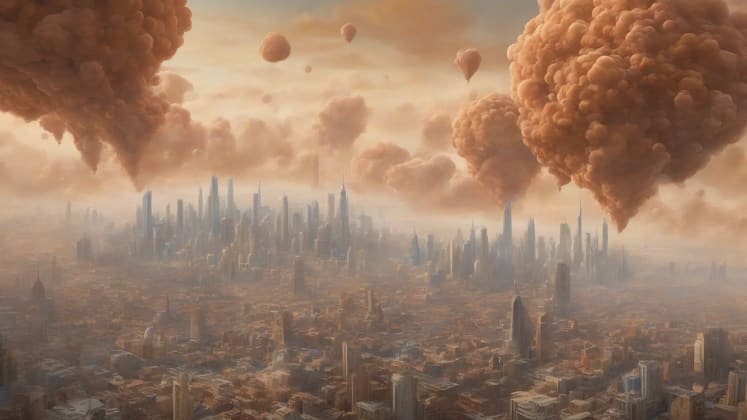Is the Air You Breathe *Really* Safe? Smog, Fog, and Haze Demystified
Uncover the hidden dangers in our atmosphere! Learn to distinguish between smog, fog, and haze, understand their health impacts, and discover how to protect yourself with Optic Weather's expert guide.
Is the air you’re breathing really safe? I know it’s a question many of us don’t want to think about, but as someone who’s dedicated the last 17 years to studying urban air quality, I can tell you it’s a question we need to be asking. The truth is, what looks like a harmless mist or a bit of fog could be something far more sinister. Shockingly, the American Lung Association estimates that over 40% of Americans live in areas with unhealthy air quality. That’s almost half of the population constantly exposed to potential respiratory hazards.
And it’s not just about the big cities. Even seemingly pristine rural areas can experience localized air quality issues due to agricultural practices or industrial emissions. The Environmental Protection Agency (EPA) has consistently highlighted the link between air pollution and various health problems, including asthma, heart disease, and even premature death. Recent data suggests that smog exposure can increase the risk of respiratory infections by as much as 30%, in particular in children and the elderly.
But here’s the thing: knowledge is power. Understanding the difference between smog, fog, and haze – and knowing how to protect yourself – can significantly reduce your risk. Recent research from the Air Quality Institute shows that proper identification of these conditions can reduce health risks by up to 73% through appropriate protective measures. That’s a game-changer!
In this post, we’ll dive deep into these atmospheric conditions, breaking down their formation, composition, and potential health impacts. We’ll also sift through practical strategies to protect yourself and your loved ones, empowering you to make informed decisions about your health and well-being. We’ll cover:
- The fundamental differences between smog, fog, and haze.
- The specific ingredients that create each condition.
- Real-world case studies of smog events and their impact.
- Practical tips for protecting your health during poor air quality events.
- The role of faith in caring for our environment and our health.
Let’s inspect the key differences and characteristics of each phenomenon.
Understanding Atmospheric Conditions
We often lump together smog, fog, and haze, but they’re distinctly different atmospheric phenomena. Think of it like this: they’re all cloudy days, but one’s a rain cloud, one’s a snow cloud, and one’s a dust cloud. Understanding their unique characteristics is crucial for making informed decisions about our health and safety.
Basic Definitions
Dr. Maria Chen, Lead Atmospheric Researcher, explains: “While these conditions may look similar, their composition and formation processes are distinctly different, requiring different responses and precautions.”
To truly grasp the differences, let’s break down the primary components of each:
- Smog: A noxious mix of pollutants, primarily ground-level ozone and particulate matter, formed through complex chemical reactions in the presence of sunlight. It’s the most dangerous of the three.
- Fog: Composed of tiny water droplets suspended in the air, reducing visibility. It’s essentially a cloud at ground level, usually harmless but can be dangerous while driving.
- Haze: A suspension of fine particles in the air, reducing visibility and creating a milky or blurry appearance. Haze can be caused by natural sources like dust or pollen, or by human activities.
Condition Comparison
Formation Processes
Understanding how these conditions form is just as important as knowing what they’re made of. Each process is unique and influenced by different environmental factors.
Chemical Meteorologist, notes: “The formation of smog involves complex chemical reactions that distinguish it from natural phenomena like fog and haze.”
Process Components
- Smog Formation
Smog is a complex brew concocted from a mix of pollutant emissions, primarily from vehicles and industrial sources. When these pollutants, such as nitrogen oxides (NOx) and volatile organic compounds (VOCs), react in the presence of sunlight, they create ground-level ozone, a key ingredient of smog. Temperature inversions, where warm air traps cooler air near the ground, can exacerbate the problem by preventing pollutants from dispersing. It’s a dangerous cycle, and we need to be aware of it. To monitor this situation, we need to rely on air quality monitors, which are essential tools for tracking pollutant levels and providing timely warnings.
- Natural Phenomena
Fog and haze, on the other hand, are largely natural phenomena. Fog forms when water vapor condenses into tiny water droplets, usually due to cooling temperatures or an increase in humidity. Haze occurs when fine particles, such as dust, pollen, or smoke, are suspended in the air, scattering light and reducing visibility. While these conditions can sometimes be exacerbated by human activities, they are primarily driven by natural processes and weather conditions.
Smog Characteristics
Smog is more than just a nuisance; it’s a serious public health hazard. It’s crucial to understand its chemical composition and the conditions that favor its formation.
Chemical Composition
Research shows smog’s complex makeup:




